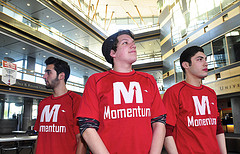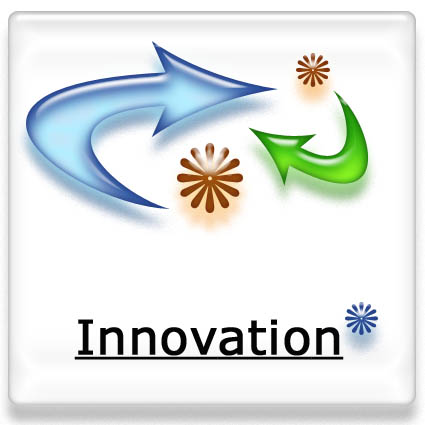Browse by Tag
- "Real" Innovation (2)
- Alignment (6)
- Business Innovation (9)
- Business Plan (2)
- Business Plans (1)
- Creativity (24)
- Critical Success Factors (4)
- Entrepreneurship (9)
- Global Competiveness (4)
- Human Side (11)
- India (1)
- Innovation (4)
- Innovation Consulting (18)
- Innovation Killers (3)
- Innovation Management (18)
- Innovation Tools (17)
- Innovation Training (24)
- Innovations (7)
- Inventions (16)
- IT Innovation (1)
- Leaders (5)
- Leadership (20)
- Leadership Development (13)
- Organizational Leadership (2)
- Organizational Strategy (20)
- Personal Values (6)
- Prediction (5)
- Strategic Innovation (38)
- strategic planning process (4)
- Strategy (3)
- Training (1)
- Vision (5)
- Weekly Dose (8)
Posts by Month
- 2014
- 2013
- 2012
- 2011
- 2010
- 2009
- 2008
- 2006
6 Components to Building Innovation Momentum
Our research and experience has led us to identify six components of building momentum and change to help you accelerate your innovation journey and lift off.

- Develop your innovation story. Develop a compelling case for innovation, what innovation is, and why the company is pursuing the innovation journey now. Include how it will benefit everyone.
- Evoke change leadership. No one likes change. During the uncertainties of a change process, people don't hang onto concepts, they hang onto people. Create a sense of urgency and build awareness and excitement about innovation for your key sponsors and change agents.
- Identify innovation leaders and best talent. Identify the natural intrapreneurs, innovation champions, and innovation igniters along with your key innovation leaders, advisors, and mentors. This talent pool will help you build the required innovation capability.
- Communicate, communicate, and communicate. Go for fast and small wins and tell everyone about it. Collect momentum data showing progress, and implement and integrate a solid public relations strategy using any and all resources at your disposal.
- Build awareness--educate everyone. In many ways an innovation change initiative begins and ends with education. It is the primary method of advancing and improving organizational knowledge and acceleration for desired changes in the hearts and minds of everyone involved.
- Protect the momentum. Vigilantly protect innovation principles. Many will want to go back to status quo and forget the agreements, processes, and principles in the playbook. Every small win is a huge step toward the future and part of the foundation-building process. Protect the foundation.
The Takeaway
Innovation momentum is created, not decreed by senior management. Use your momentum to establish your innovation objectives and goal.
Over to you. Please comment below.
- What steps would you add to the list?
- How do you motivate your innovators?
- Please share an anecdote about innovation momentum.
Innovation Isn't Just About New Products
 The innovation mindset isn't just about product innovation.
The innovation mindset isn't just about product innovation.
Some organizations have focused on product innovation for so long they don't know how to innovate in any other areas. For example, in 2010, Microsoft -one of the world's best product innovators for the last two decades - launched a social phone called Kin. The product was a complete disaster. Within six weeks of the launch, the entire product group was shut down, and, according to their earnings reports, Microsoft took at least a $240 million write-off.
How could such a great product innovator strike out so fast? In today's climate, it happens to the best.
Most organizations focus on building short-term product innovation engines. However, most products have little sustainable competitive advantage and never generate a profit; those that do are often quickly copied by the competition, negating any long-term advantage. The result: a significant investment in product development, without a commensurate return on investment.
To achieve sustainable growth, companies must better integrate product innovation with business model, process, and service innovations.
Microsoft Innovative - YES according to AD in WSJ
Microsoft is famous for its back story of a couple of nerds who changed personal computing for the entire world. They went from a few thousand dollars in revenue to$70 billion in revenue each year. They must have been innovative to accomplish such a feat and have $77 billion in the bank. They just spent $7 billion of that hard earned cash to buy Nokia's Devices & Services business.
READ MY LIPS - WE ARE INNOVATIVE
Then, why did they have to point out not once, but twice about innovation in their full page ad on the back page of Section A in the Wall Street Journal? Here are the two quotes with emphasis and commentary added by me.
"By bringing together these great teams together, Microsoft will be able to deliver more choices and faster innovation to consumers in phones and smart devices of all kinds"
I thought a couple of years ago that Microsoft gave billions of dollars to Nokia and its CEO Stephen Elop (a former Microsoft executive) to accomplish the task already. Microsoft and Nokia were already joined at the hip as partners when Nokia gave up its own operating system in favor of Windows.
Staples has the "Easy Button." Perhaps, Mr. Elop has the "Innovation Button."
"Together, we will create more unified development, manufacturing, and marketing efforts to bring innovation to market with greater efficiency and speed."
The market did not think so, and erased 4.6% of Microsoft's share price after the announcement. That decline in share price pretty much wiped out the nice bump in Microsoft shares after CEO Steve Ballmer indicated he would retire within 12 months.
A THIRD EXAMPLE OF PUTTING YOUR MONEY WHERE YOUR MOUTH IS
Ballmer went on to say in a Wall Street Journal story on the same day,"For us to really fulfill the vision for what we can do for our customers, we have evolved our thinking."
Very recently Ballmer announced the "devices and services" approach at Microsoft after a major reorganization of the 100,000 person company (now 132,000 after Nokia acquisition). Sounds like he is going all in for devices. Other than the X Box gaming device, Microsoft does not have a successful record creating hardware. See Surface Tablet and Microsoft's recent $900 million write off for unsold inventory.
The Takeaway
You need an Innovation Engine to help create an ecosystem of innovation. You cannot decree it, you must work hard to create it.
Your turn. Tell me what you think. Please comment below.
- Does your business have a culture and climate of innovation?
- What is the most innovative new product or service your company has created in the last 5 years?
- Do you feel that Microsoft and Nokia can out innovate Google's Android platform and Apple's iPhone platform?
Leadership Challenge: Ban Inertia for Sustainable Organizational Health
A place of inertia; indecision, inability to act or move forward, fear of the unknown, not enough information or knowledge, resistance, a lack of direction or clarity. We've all been there at some level, at some point, be it professional, organizational, health, investments, relationships or a major purchase.
Implementing sustainable innovation in your organization where there is resistance to change is a lot like changing your diet and adopting a regular exercise program for healthier lifestyle. It makes sense, everyone sees benefits, but implementation is frustrating - our habits may not be the healthiest, but we know them and have a comfort level. We live with them daily and the surprise factor is small, until they catch up with us and a crisis ensues. In hindsight our flawed thinking and outdated strategy become glaring, and the "fix" more difficult if not improbable.
To make any type of significant progress, first there must be intent to change. Resources must be found, and time committed. The principles are fairly basic and simple, but do they all apply to you? Change demands you let go of something or take a chance in order to effect a change, which may or may not ultimately prove beneficial if you choose carelessly or hastily - change always brings risk of injury or loss as well as possibility for great benefit; two sides of the same coin.
- The issue which requires change first needs to be clearly observed and defined - critically look in the mirror and acknowledge it's time to move beyond torpor and procrastination and become more flexible, nimble, defined and stronger.
- Strategy must be timely and align with existing structure and goals - be realistic about your resources and mindset.
- Assess your options, initially scrutinizing all seemingly viable avenues, seeking other opinions and recommendations from diverse conventional and unconventional sources.
- With intent, goal, and commitment in mind, begin to design your sustainable program for ongoing organizational health.
Organizationally speaking, present barriers, opportunities, quantity and quality of knowledge, choices, focus, and risks, will define future possibilities and vision. This Contextual Canvas, is the landscape that ultimately gives rise to innovations. Expand the size of the canvas - increase your knowledge and awareness base for growth - and the probability of finding answers as to how or what is next arises.
OPPORTUNITES ARE JUST AROUND THE CORNER
Opportunities are already present within our organizations, just waiting to be discovered. Clarity is often lacking. Yet, clarity is only one half of the equation to reduce risk and uncertainty. Speed is the other half. Letting fear of risk define your innovation efforts is like snacking large at midnight - the weight goes on and more inertia sets in. Instead of playing it safe, "Play" with worthy ideas, big or small - dip the toe, eat the kale, run the 5K, experiment more and build on your insights, growing useful context.

In short, no matter the focus of your innovation, make innovation itself a core focus, with fast experimentation on a number of fronts. This will yield clarity about functional elements of your prospective solution.
Innovation requires strategic planning, alignment with core values and stakeholders, sufficient investment, continuous idea generation, continuity of effort, sustainability and above all, taking charge. Leadership commitment and skills are essential - to pursue your vision you must become proactive leaving passive acceptance of status quo behind, jumping into the lake with both feet, yet with awareness of where the shores lie, and swim like crazy.
Need more information, help or guidance? Visit our downloads page for great articles, videos and podcasts, or About Us for easy access to Strategy Development, Training & Workshops, and Customer-Centered Innovation.
Leadership role? Visit Innovation Tools.
What is Commodity Island and why should I be concerned about it?
Executives are concerned that their product and services offerings are being commoditized. For every move they make, competitors are responding quickly and at a seemingly lower cost basis. They are stuck on Commodity Island.

Often, the organizational focus has shifted to a ‘win at all cost’ mentality with very complex pricing models. Everyone is doing the same, and now everyone look and feels the same to the customer.
Some organizations miss their window to "Jump the S-Curve": leaders must disrupt the current business for new growth, before draining the life out of the existing business. Otherwise they will be stranded on Commodity Island.
Innovating your way off Commodity Island requires visionary leadership, organizational culture change, and effective employee engagement. Read about our Innovation Execution Methodology and chart your path to new business growth.
IT Leadership: Grab A Tiger by the Tail
Shortly after taking office, President Obama’s CIO (Vivek Kundra) formed a “tigre” team (technology, innovation, and government reform) in order to implement IT reform within the US government The US IT budget representing an astounding $80B, representing over 2,000 data centers.

This recent article by the Sydney Morning Herald highlights Mr. Kundra’s focus on IT transparency including an online IT dashboard with performance rankings. The result of his effort was a shift towards consolidation (to increase datacenter capacity) and virtualization (to leverage cloud-based provisioning speed and consumption based costing).
While Mr. Kundra has since moved on (he joined Salesforce.com after a brief stint at Harvard), his innovative IT dashboard lives on as an open source offering. More importantly, he highlighted the importance and value of IT transparency.
Corporate IT department can learn a lot form Mr. Kundra’s TIGRE initiative. The most important lesson and most difficult being practices of transparency. If your IT organization is trying to figure out how to drive more value, innovation can help, but innovation without transparency will give you only average results. IT leaders can produce breakthrough value by building innovation behaviors at every level. This requires transparency between employee and their managers, and transparency between IT and the business units.
Innovation at the World Economic Forum: Apple vs. Google
Apple vs. Google… Creativity vs. Science… Convergence and Collaboration
If you’re curious where the world is heading and what is top of mind for global leaders, there’s few better vantage points than from Davos and the World Economic Forum.
World-changing innovation is also discussed at Davos.
This year, there was an interesting discussion about innovation by consultant John Kao, as reported by the New York Times (click here for the original article).
The innovation discussion and article focused on the differing strategies of Apple and Google.
Mr. Kao compared Google and Apple’s approach to innovation, pointing out it “highlights the ‘archetypical tension in the creative process.’”

The article notes, “The Apple model is more edited, intuitive and top-down. When asked what market research went into the company’s elegant product designs, Steve Jobs had a standard answer: none. ‘It’s not the consumers’ job to know what they want.’”
Regarding Google, the article reasons: “Google speaks to the power of data-driven decision-making, and of online experimentation and networked communication. The same Internet-era tools enable crowd-sourced collaboration as well as the rapid testing of product ideas — the essence of the lean start-up method so popular in Silicon Valley and elsewhere…”
Importantly, the article quoted Errol B. Arkilic, program director at the National Science Foundation, on the important use of “the scientific method to market-opportunity identification.”
While not expressly mentioning it, the article highlighted the value in collaboration. In fact, regarding the importance of collaboration, the article referenced how some of Apple’s top ideas have been sourced through collaboration.
Consider these article highlights about Apple:
“Apple product designs may not be determined by traditional market research, focus groups or online experiments. But its top leaders, recruited by Mr. Jobs, are tireless seekers in an information-gathering network on subjects ranging from microchip technology to popular culture. “
The article further notes that Apple’s early computing design included a point & click mouse and graphical, on-screen icons that came from a visit to Xerox’s Palo Alto labs; and Siri, a more recent acquisition and now key iPhone feature, originated in the Pentagon’s DARPA.
Wow! What innovation nuggets.
Apple leaders tirelessly pursue convergences of market data and trends - and collaboration with other entities has been critical to Apple’s success. It would be interesting to apply our Innovation Styles diagnostic across Apple leadership to see if they have a mix of complementary styles.
Interestingly, we at The DeSai Group have been focused on two fundamental drivers to innovation: 1.) convergence of market issues/trends; 2.) collaboration. And it looks like these strategies have been responsible for some of the world’s top innovations.
That’s good to know, especially today as I am currently leading several innovation leadership sessions with a major India-based, multi-national conglomerate in Mumbai, Hyderabad, Bangalore, and Chennai, India.
I’m guiding the innovation discussion by summarizing global trend convergences and identifying how specific collaborations can make a major impact in the world. And we’re specifically addressing key concerns voiced at the World Economic Forum.
What do you think about Apple vs. Google’s approach to innovation?
-Jatin
Innovation is about "Getting Out of the Box"...So what?
What do we mean by “The Box”? Is this outside or inside of us? If you think about it The Box is who we are today – made up of deep beliefs and assumptions from our life’s experiences so far. Everyone’s boxes are different and unique. We tend to associate with and hire people who have a box similar to ours: not a good practice if one wants to expand and grow.

To help you discover your own box, here are some questions for you to think about.
- Where is this Box? What material is it made up of? How tall is it? How big is it to others?
- Who can come in your box? Who cannot?
- Does everyone have a box?
- When one is born, did the box exist? How does it get created?
- What is the role of parents in creating the box for their children?
- What is the role of a manager in crafting a box for new hires, especially new graduates?
The Box is one’s “context” or “point of view” about what is right and what is wrong.
Most of us are happiest when we are at the center of the box. We don’t like to be pushed to the corner of the box. We get scared. What does that mean?
The center of the box is where the left brain is most happy. It is where everyone around expects us to be in order to do “the work” assigned to us. Most of us work from the center of the box on a daily basis – routine patterns, nothing new, boring, etc.
The best innovators are keenly self-aware of their own box and its characteristics. They also have trained themselves to go to the edge of the box on daily basis. They also “jump-out of the box” often to find new ideas, see what others don’t see, and are not fearful. They are “lost” (deeply loving what they do) when they are away from the center of the box. They in fact hate being stuck in the center of the box. Most people look at them as “different.” They become innovators because of their out of the box qualities along with an ability to navigate organizational systems and overcome deeply rooted orthodoxies. They can be considered corporate missionaries.
Finally, the very best, the world-class innovation leaders are fully aware of their box and also the boxes of others around them. They also love to get outside the box. So what is the difference between the best and the world-class? The world-class innovators also know how to pull others outside of their respective boxes as well.
Organizations must learn to create a pipeline of such leaders to deal with the complex and fast changing world.
What is your organization doing to institutionalize out of the box environment and reward out of the box thinking?
Role of HR in Innovation
Innovation is the catch word for our generation. Everywhere we look at, we find innovation. There was a time in history when invention was innovation. At the brink of inventing all, innovation is invention. The bottle of beverage is redefining its shape. Every communication device is undergoing metamorphosis. 2G to 3G, rectangular to modular technologies, the world is experiencing change through break neck innovation.
We wonder about the soul of innovation! Is it a collective mind frame which innovates? Do innovation leads to more innovation? Or there is an innovator behind every innovation?

Innovation is definitely a social mind frame. If not initiated participated by all. Whenever something new hits the town and if dubbed happening by a group of people, like a shoal of fish, we run after it to part of the experience. That means innovation is started by an innovator and followed by the masses. Innovation leads to further innovation! That is true but there has to be some innovator to start this chain reaction. Thus innovation is all about the innovator.
Innovator is no one but someone among you and me. It is the human brain which innovates. Finding such brains is the real job of our HR Dept. A successful HR professional is always an innovator who identifies the resource who can do trendsetting innovation.
Unfortunately the industry is swarmed by unsuccessful HR techniques which fail to identify the real innovator. What is the relevance of totemistic queries like, “How experienced you are? And tell us about yourself? How about your achievements and breakthroughs? Who are your clients?” And all statistical queries far removed from finding the real innovator with innovation mind. We are not proposing these queries are irrelevant at the time of selecting candidates however we are questioning its relevance in terms of the context of innovation.
An ideal HR professional shouldn’t be task master or recruitment software. Beyond the plastic smile he/she should have a sensibility to understand the processes one practice to understand and implement business techniques. One should delve in detail to understand the outlook of an interviewee when it comes to innovation.
However no HR is born with these skills. An integrated HR innovation package can help them tremendously in recruiting innovative personnel in the managerial wire frame of an organization.
How Innovative is your Organization?
You must be having certain parameters or yardsticks to judge the performance of your organization and exactly calculate the return on investment (ROI) vis-à-vis the planning, the performance and the potential. Despite all the available mechanisms of analysis, most leaders fail to understand the immeasurable gap between speculations and reality. The root cause of this immeasurable gap can certainly be tracked down to a few intangible factors. Primary among them is the capacity to innovate for a particular brand, organization or a corporate entity.
Innovation Obstacles
The major problem faced by an organization is the absence of a clear directive or formula to innovate. The work force, which is a major decider of innovation, largely works as a cog in the machine rather than a radical unit intelligent enough to innovate as hierarchical processes are better preferred by a linear human resource.
Another area which makes innovation a difficult process to be imbibed by your workforce is lack of liberty to express in a highly structured system. Whenever there is lack of liberty at an individual level, an organization fails to innovate on the whole. More structured-driven the culture, harder it is to embrace innovation; which by its nature, is somewhat unstructured.
Organizational culture is a result of inherited and tolerated past behaviors of the staff; especially the leaders at the top. Organization suffers from lack of innovation due to contemporary business practices and the nearby environment it operates in. Thus, innovation as a process should begin at the level of an individual with full support of the leaders. This can lend a character to an organization where performance, profit and potential grow manifold by significant innovation on intangible, impromptu research, and management decisions.

How ready is the culture for innovation?
How adept your workforce is with a dynamic knowledge system or how porous they are with circumstance fluctuation are simple questions which help you to approximately understand how innovative your organization is. However, to ensure that your organization is ready for such innovation trials you need to first make sure that your organization is innovation-ready.
At The DeSai Group, our innovation consulting processes are deliberate and drastic. They are designed to be transformative in nature. We believe in a sustained innovation strategy instead of piecemeal innovation. This means that our consulting techniques rely heavily on a dramatic change to completely undermine forces of resistance and new growth opportunities. As necessity is the mother of invention, we facilitate an environment in your organization where necessity is induced to alter psychological performance and create a climate of innovation. The process makes your workforce rehearse find measures of self-innovation. This means there are real entrepreneurs working on their passions in an environment that promotes experimentation, risk-taking, and future thinking.
The right brand image within insiders of an organization is a necessary precondition for any kind of innovation. If a nagging employee has a negative attitude toward the organization’s optimism the result is not only affecting the performance of the concerned individual but the overall environment as well. Such individuals can be motivated through vigorous team-building and venturing skills.
The process of innovation is largely a psycho-social process wherein knowledge transfer and experiential methods are largely employed to achieve the goal. We, here at The DeSai Group, clinically approach the intangibility quotient of innovation through hard-core rational, analytical science we call “Innovation Execution Methodology”, while keeping in mind that innovation is also very much a form of art and it is the artistic and unpredictability that actually gives rise to new ideas for commercialization and value generation.

